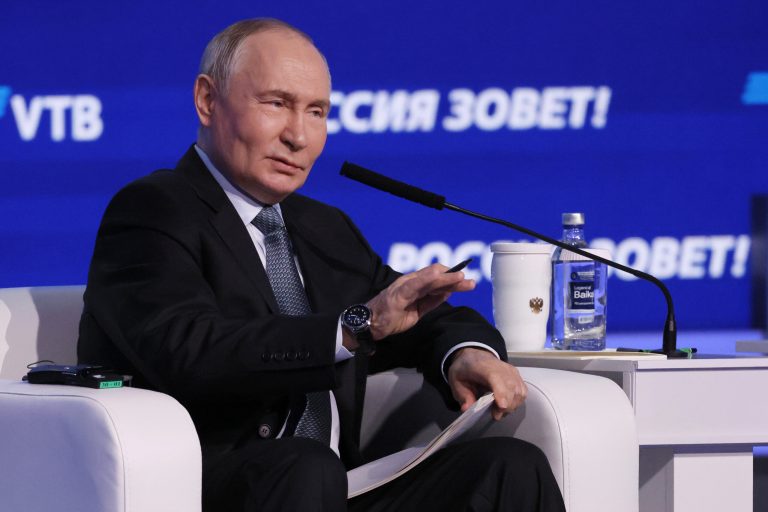Russia Wages Disinformation War to Undermine US Support for Ukraine Amid Biden’s Final Days
As President Joe Biden dedicates his remaining time in office to bolstering Ukraine’s defenses, Russia is engaged in a covert campaign of disinformation aimed at eroding American support for the embattled nation before Donald Trump’s return to the White House. Leveraging state-controlled media, networks of fabricated news websites, and social media accounts, the Kremlin is disseminating divisive narratives about the war and the Republican president-elect. This content, specifically translated for American consumption, seeks to sway public opinion against Ukraine, aiming to diminish US military aid and pave the way for a Russian victory.
This disinformation campaign has escalated since the November 5th US election. Fabricated videos purporting to show Ukrainian soldiers burning effigies of Trump or his supporters, or expressing opposition to his presidency, have been widely circulated. These videos, riddled with telltale signs of digital manipulation, have been debunked by multiple researchers. Similarly, a video depicting Ukrainian soldiers firing at a mannequin dressed in Trump attire has been exposed as a fabrication by both private analysts and Ukraine’s Center for Countering Disinformation.
Further fabricated videos portray Ukrainian soldiers destroying Trump’s books or labeling him a coward. These clips have rapidly spread beyond Ukraine and Russia, infiltrating online communities of Trump supporters and adherents of the QAnon conspiracy theory. This disinformation push is part of a broader Russian strategy to sow discord among Americans regarding the nearly three-year-long conflict, portraying Ukrainians as untrustworthy allies. By undermining American support, the Kremlin seeks to sever the crucial flow of military assistance that has sustained Ukraine since Russia’s invasion in February 2022.
From the outset of the war, Russian propaganda has painted Ukrainian leaders as corrupt, harboring Nazi sympathies, or involved in bioweapons research linked to the COVID-19 pandemic. These false narratives were used to justify the invasion. Now, the narrative has shifted towards portraying Ukraine as unworthy of support. The fabricated video of soldiers firing at the Trump mannequin, for instance, gained traction on platforms like X, Telegram, and YouTube, initially amplified by pro-Kremlin news sites before migrating to platforms frequented by Americans. Some iterations of the video, predating the election, were presented as recent events. Within days, the video garnered hundreds of thousands of views and was translated into multiple languages.
US intelligence assessments indicate that Russia sought to bolster Trump’s candidacy, believing he would curtail American support for Ukraine and potentially weaken the NATO alliance. Trump’s past praise of Vladimir Putin, criticism of US military aid to Ukraine and NATO, and promises to swiftly end the war suggest a potential inclination towards pressuring Ukraine into territorial concessions. The Russian Embassy in Washington has denied any involvement in spreading disinformation, reiterating previous statements rejecting such accusations.
In its remaining time, the Biden administration has urged Ukraine to rapidly expand its military through increased conscription and has expedited weapons shipments, alongside forgiving billions in loans. The US has allocated over $56 billion in security assistance to Ukraine and anticipates sending billions more before Biden’s departure in January 2025. Russia’s motivation to disrupt this aid is evident, but the efficacy of its disinformation campaign, particularly on social media platforms already saturated with false and misleading information, remains difficult to assess. One contributing factor to Russia’s persistence with disinformation targeting Americans is the relative ease and low cost compared to diplomatic or military interventions.
Russia likely views disinformation as a long-term strategy to weaken America’s global standing by dividing its populace and eroding trust in its institutions. Regardless of the specific topic – immigration, government, the US economy, or the war in Ukraine – the overarching goal remains to sow discord and undermine confidence, extending beyond any single election cycle or candidate. While a contested election outcome with widespread unrest was likely a desired scenario, Russia’s disinformation apparatus will continue to propagate narratives aimed at inflaming American public opinion and advancing its objectives in Ukraine. This sustained effort underscores the ongoing threat posed by disinformation in shaping public discourse and influencing geopolitical dynamics.


